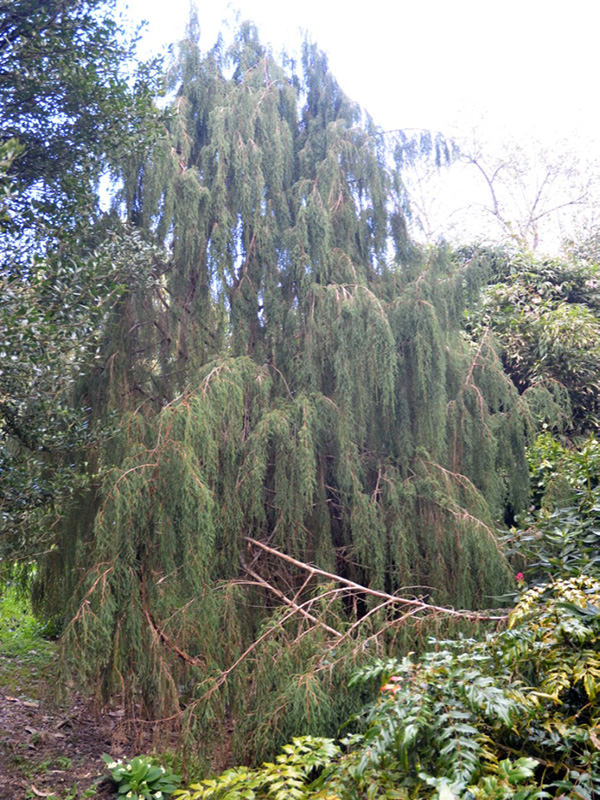
Woody > Juniperus > Juniperus recurva > Juniperus recurva
Juniperus recurva
Himalayan Weeping Juniper, Drooping Juniper, Coffin Juniper
Origin: Native to the North of the Himalayas and northern Pakistan east to western Yunnan in southwestern China.
Mike's
Opinion


"
Juniperus recurva is a grand and elegant tree with weeping branches and beautiful, rusty coloured bark.
Michael Pascoe, NDP., ODH., CLT., MSc. (Plant Conservation)
"
| Family |
| Cupressaceae |
| Genus |
| Juniperus |
| Species |
| recurva |
| Category |
| Woody |
| Type |
| Tree (evergreen), Shrub (evergreen) |
| USDA Hardiness Zone |
| 7 - 9 |
| Canadian Hardiness Zone |
| 7a - 10a |
| RHS Hardiness Zone |
| H5 - H6 |
| Temperature (°C) |
| -17.8 ºC |
| Temperature (°F) |
| 0 to 10 ºF |
| Height |
| 6-10 m |
| Spread |
| 4-6 m |
Photographs
Description and Growing Information
Flowering Period
| General Description |
| A nice elegant form that’s asymmetrical, pointed, and makes a fair-sized tree. With attractive foliage on pendant weeping branches, blue/ green in the summer, turning a much darker green in the winter and with a rusty-brown bark. |
| Landscape |
| Valued for its drooping, weeping foliage, in the Himalayas the tree is often used as windbreaks. |
| Cultivation |
| The Himalayan Weeping Juniper is a tender plant, but can withstand lows to about 10 °F, however it cannot handle extreme temperatures of hot or cold. Tolerant of different pH levels; acid, neutral and basic, but prefers neutral or slightly alkaline in soils that are sandy (light), loamy (medium) to clay (heavy) or chalk. Soil moisture should be well-drained, dry to moist. |
| Shape |
| A large shrub or a small tree with an uneven, cone-shaped habit. |
| Growth |
| Slow |
| ID Characteristic |
| Impressive, conical form that is a quite distinctive from the rest of the junipers. With its needle-like blue/green foliage that hangs on slim, graceful, weeping branches, and dark purple berry-like cones. Bark is exfoliating orange-brown, which lights up in the evening sun. It is very slow growing producing about 30 cm or more of new growth per year. |
| Pests |
| Red spider mite infestations are common in warm weather, and must be treated early. |
| Habitat |
| Woodlands of the wetter areas of Himalayas (altitude of 1800 m to 3900 m), with moist, well-drained soils with a pH of neutral or slightly alkaline. Preferring wet climates and humidity. |
| Bark/Stem Description |
| Bark is rough, orange/ brown which is flaking or exfoliating in long strips. |
| Flower/Leaf Bud Description |
| Ovoid or conical, light green, 1.3 cm long, resinous with loose scales. |
| Leaf Description |
| The blue/ green needle-like foliage, approximately 5-10 mm long, hangs down loosely and is arranged in six ranks in alternating whorls of three. |
| Fruit Description |
| The cones are a light green turning a glossy dark blue/black berry-like, spherical to egg-shaped as it matures. The cones are light brown, 3-4 mm in length. |
| Colour Description |
| The needle-like foliage is bright green in the summer, turning a darker green in the winter, and the cones a glossy dark blue/black. Has rusty orange-brown bark that lights up in the evening sun. |
| Texture Description |
| Has a coarse texture, and an exfoliating bark. |
| Notable Specimens |
| Westonbirt, The National Arboretum, Tetbury, Gloucestershire, England. |
| Propagation |
| Usually propagated by seed, cuttings or grafting. To propagate the Weeping Juniper from seed, it needs to go through a period of cold stratification, followed by a warming period, then a cold spell again, each for about 2-3 months. This is required since the seed has a hard coat and is very slow to germinate. To help speed up the germination process, give the seed a 3-6 second soaking in boiling water. Cuttings can also be taken once wood has matured, collect a 5-10 cm cutting with a heel, during September/October. |
| Ethnobotanical Uses (Disclaimer) |
| Timber is used for manufacturing coffins in China and trees are used as windbreaks in the Himalayans. |
References
Adams, R. (2004). Junipers of the world: The Genus Juniperus. Vancouver, B.C.: Trafford.
Farjon, A., & Filer, D. (2013). An Atlas of the World's Conifers: An analysis of their distribution, biogeography, diversity, and conservation status (p. 524). Brill.
